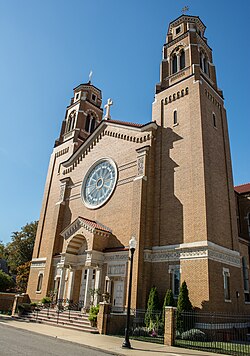St. Clair–Superior is a neighborhood on the East Side in Cleveland, Ohio, in the United States. Largely settled in the 1880s and 1890s by Eastern European immigrants, white flight in the 1990s left the neighborhood largely African American. It is one of the oldest and most culturally diverse neighborhoods in Cleveland today.
St. Clair–Superior | |
|---|---|
 St. Vitus church at the corner of East 61st and Lausche Avenue | |
 | |
| Country | United States |
| State | Ohio |
| County | Cuyahoga |
| City | Cleveland |
| Population | |
• Total | 5,580 |
| Demographics[1] | |
| • White | 18.8% |
| • Black | 75.6% |
| • Hispanic (of any race) | 5.8% |
| • Asian and Pacific Islander | 1.5% |
| • Mixed and Other | 4.2% |
| Time zone | UTC-5 (EST) |
| • Summer (DST) | UTC-4 (EDT) |
| ZIP Codes | 44103 |
| Area code | 216 |
| Median income[1] | $22,961 |

About the neighborhood
editSt. Clair–Superior boundaries are: E. 55th Street from Lake Erie south to Superior Avenue; Superior Avenue east to Martin Luther King Jr. Drive; Martin Luther King Jr. Drive north to Lake Erie.[2]
The neighborhood lacks access to Lake Erie and Gordon Park due to the presence of Interstate 90 and major railroad tracks. Access to Rockefeller Park is also highly limited. The neighborhood's main retail district lines St. Clair Avenue.[3]
History of the neighborhood
editSt. Clair–Superior was largely rural and sparsely populated until the 1880s and 1890s, when extensive construction of heavy industry and manufacturing plants occurred along the railroad tracks and the area north of St. Clair Avenue. Large numbers of immigrant Slovenians and Lithuanians moved into the area to work in these plants.[3] The historic St. Vitus's Church, at E. 61st and Lausche Avenue, was the first Slovenian Catholic church built in Cleveland, and at one time was among the largest Slovenian congregations in the United States.[4] Eastern European immigrants brought with them a long beer-making tradition, and during the 1800s and early 1900s the St. Clair–Superior neighborhood was known as "the mecca of breweries in Cleveland."[5] In the summer of 2016, the brewing tradition returned to the neighborhood, with the opening of Goldhorn Brewery, which takes its name from a Slovenian folktale and features beers named to commemorate neighborhood specific people and places.[6]
The majority of residents in the neighborhood were whites of Eastern European ancestry at least as late as 1991.[7] A major demographic shift occurred in the 1990s and 2000s, so that by 2020 75.6 percent of residents were African American, and 18.8 percent white and 5.8 percent were Hispanic.[1]
Connected to its Slovenian cultural roots, Cleveland Kurentovanje has been celebrated every year the weekend before Ash Wednesday since 2013.
In 2015, some redevelopment began to occur in the area. One of the biggest projects was Hub 55 on E. 55th Street, a redevelopment that housed a café, market, meeting space, and office space.[7] Most of Hub 55 opened in June 2015.[8] The investors in Hub 55 planned additional redevelopment as of the fall of 2017.[5]
By 2015, 33 percent of all homes in the neighborhood had been demolished after falling into disrepair. Another 25 percent of homes in the neighborhood are vacant. Of these vacant homes, the Western Reserve Land Conservancy's Thriving Communities Institute property survey rated nearly 12 percent rate as "distressed" (an extreme degree of disrepair). This compares to just 9 percent in distressed neighborhoods like Buckeye–Woodhill, Glenville, Hough, and Kinsman.[7]
The level of reported crime in St. Clair–Superior is not much different from those in gentrifying neighborhoods like Ohio City or Tremont.[7] Unreported crime, however, remains high.[5]
Schools
editSt. Martin de Porres High School (a Catholic school) and a branch of Horizon Science Academy (a charter school) are both located in St. Clair–Superior.
In 2003, St. Martin de Porres High School, which was located in the former St. Vitus School building, began construction of a $30 million new campus a block away. The first, $21 million phase of the project opened in April 2018. The new building incorporated the facade and copper domes of the historic Kausek Brothers building, a former department store.[9]
References
edit- ^ a b c d "Cleveland Neighborhoods and Wards: St. Clair–Superior Neighborhood Factsheet (2021)" (PDF). The Center for Community Solutions (Cleveland). Retrieved June 3, 2022.
- ^ Cleveland City Planning Commission (January 17, 2014). Cleveland 2014 SPA's (PDF) (Report). Cleveland. p. 1. Retrieved September 24, 2017.
- ^ a b Cleveland City Planning Commission (2006). "District 5: St. Clair–Superior. Connecting Cleveland 2020 Citywide Plan". Cleveland City Planning Commission. Retrieved September 24, 2017.
- ^ "St. Vitus Church". Encyclopedia of Cleveland History. 2017. Retrieved September 24, 2017.
- ^ a b c Oprea, Mark (September 23, 2017). "Hub 55 aims to turn its namesake into a destination". Crain's Cleveland Business. Retrieved September 23, 2017.
- ^ DeMarco, Laura (October 27, 2016). "Excellent Goldhorn Brewery on East 55th Street merges Old World and New". The Plain Dealer. Retrieved September 25, 2017.
- ^ a b c d Dissell, Dissell (November 21, 2015). "Hope remains in St. Clair–Superior, one of city's most distressed neighborhoods". The Plain Dealer. Retrieved September 24, 2017.
- ^ Petkovic, John (June 25, 2015). "Cafe 55 opens in new Hub 55 complex in Cleveland". The Plain Dealer. Retrieved September 25, 2017.
- ^ O'Donnell, Patrick (April 27, 2018). "New St. Martin de Porres High School opens on Cleveland's East Side". The Plain Dealer. Retrieved April 28, 2018.